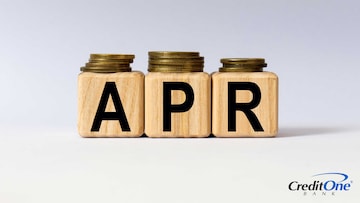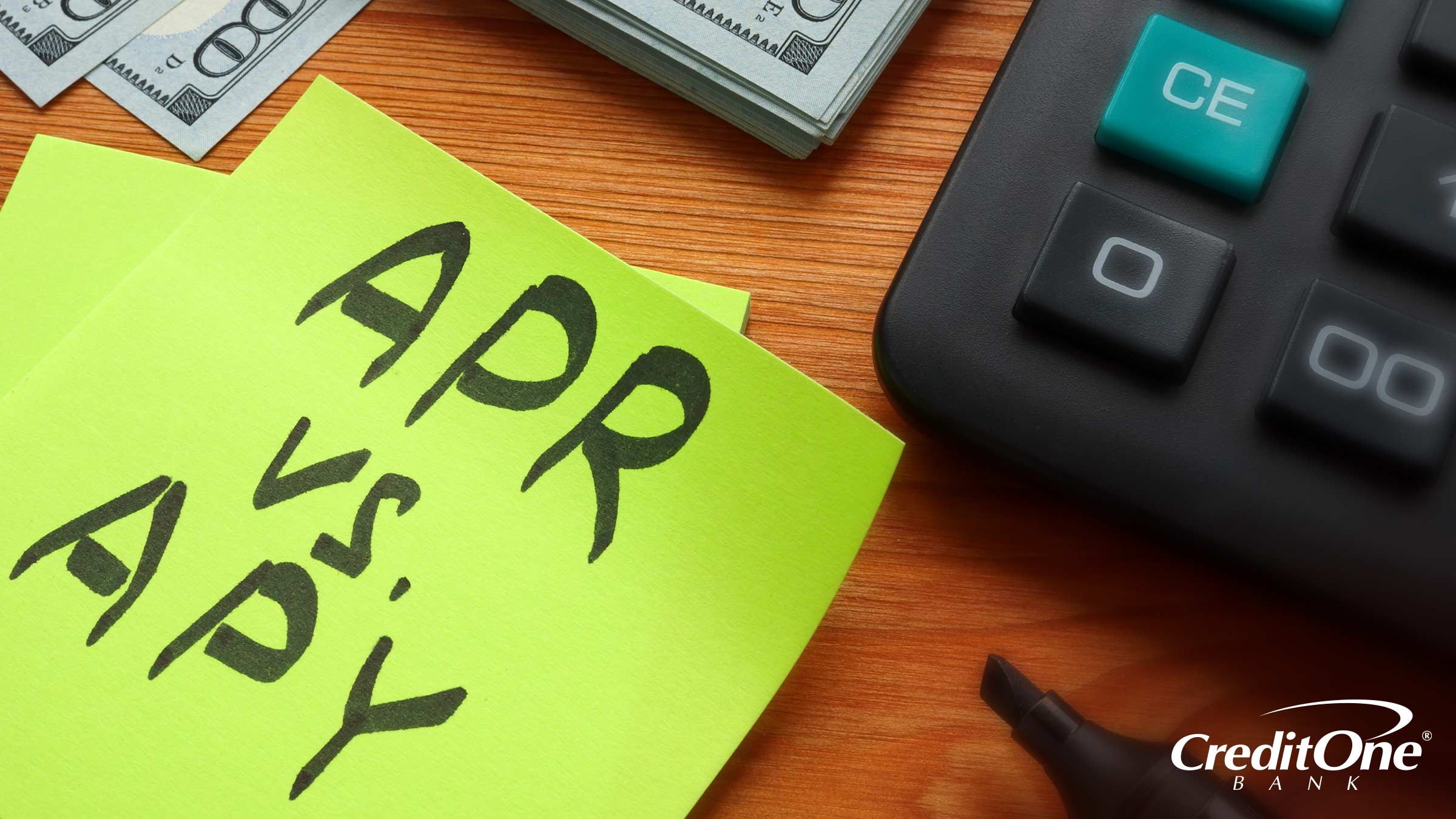
Annual Percentage Rate (APR) vs Annual Percentage Yield (APY)
July 16, 2024
APR and APY sound similar, so many people get them mixed up. Here’s what each term means and when to use it.

Introduction
It’s natural to be confused about the difference between APR and APY. They’re both related to interest rates, and they’re kind of like two sides of the same coin. An APR represents the cost of borrowing money, while an APY reflects what you can expect to earn on an investment or savings.
But understanding the specifics of how they each work and how interest is charged (or earned) is essential if you want to stay in control of your finances.
What is APR and How Does it Work?
The annual percentage rate (APR) refers to the actual percentage you pay each year on the balance of a credit card or loan. It includes the interest rate and any fees or other costs associated with securing the loan. However, it doesn’t account for compounding interest.
APR is associated with borrowing money, including:
- Credit cards
- Personal loans
- Personal lines of credit
- Auto loans
- Student loans
- Credit-builder loans
- Payday loans
- Mortgages
- Home equity lines of credit
What is the difference between APR and interest rate?
The APR is often called the interest rate, but the interest rate is really just one part of the APR calculation.
For a loan, your APR will also include origination fees, aka service fees, administration fees, or processing fees. These are often based on a small percentage of the principal, and they cover the administrative costs of underwriting your loan. Lender fees may be taken care of before you receive the funds, but you should never have to pay them out of pocket as a condition for getting approved.
The fee may either be subtracted from the principal, or added to it.
- Subtracted: If the loan amount is $10,000 and the fee is 5% ($500), you will receive $9,500.
- Added: With the same numbers, the $500 is added on top, so your loan will ultimately be for $10,500.
Whichever option you get will affect how much you pay over the long term. If the fees are added to the total, you’ll pay interest on that amount as part of your principal.
For credit cards, the APR and the interest rate are usually synonymous because there aren’t additional loan fees. Credit card late fees and annual fees aren’t included in the APR.
What is APY and How Does it Work?
The annual percentage yield (APY) is the total percentage you can earn on a savings account, certificate of deposit (CD), or investment. Unlike APRs, it includes the effect of compounding interest as well.
While some people also use the term APY to refer to loan or credit card rates with compound interest included — and talk about the difference between APR and APY on a loan — you’ll most often see it as an earning rather than an expense. So instead of it being something you pay on your loan or credit card, it’s the amount you can earn on a deposit or investment.
APY is associated with earning returns, including:
- Investments
- Savings accounts
- Money market accounts
- Certificates of deposit
What is the difference between APY and interest rate?
Again, some people use APY and interest rate interchangeably. However, the APY includes the effects of compound interest on the interest rate — and compounding is the key difference between the two terms.
Both APY and interest rates are conveyed as percentages:
- APY is the percentage of money you earn over the course of a year, factoring in compound interest.
- Interest rate is the percentage of money you earn over the course of a year, without compounding.
What is compound interest?
Compound interest is calculated on the original amount plus the interest already earned. So each time it’s compounded — usually monthly, quarterly, or annually — you’re earning interest on the interest.
If the bank only offers simple interest, where no compounding takes place, it’s not called an APY. Instead, you’ll only see the interest rate.
Why is APY higher than the interest rate?
An interest rate can be listed on a product that includes compounding, but the APY must be included as well. In this case, the APY will be higher than the interest rate because the APY includes the interest on the original balance as well as the compound interest you earn during that year.
It’s important to know the APY, rather than just the interest rate, when you’re choosing a savings account or deposit product. If you’re considering a high-yield savings account or CD but don’t see the APY stated anywhere, it may not offer compound interest.
Difference Between APR and APY
In a nutshell, APR is what you pay and APY is what you earn.
- APR is the cost of borrowing, like on a credit card or loan.
- APY is the rate of return, like through investments and deposits.
So APR is an outgoing amount while APY is incoming. And they apply to different types of financial products, but both are expressed as a yearly percentage.
Of course, many variables are involved in financial calculations, including grace periods, transaction types, and promotional rates. How much you’ll ultimately pay in credit card interest depends on how you use your credit card and how interest is charged to your account. What you’ll earn in savings interest depends on how you use or move your money.
Different APRs You Should Know About
APRs are often simpler to figure out than APYs, but you need to know about the different rates you might have based on the transaction type and timing.
- Fixed-rate APR: This is rare in credit cards, but it’s common in mortgages and other loans. A fixed-rate APR remains the same for the life of the loan, regardless of how the economy or federal interest rates change.
- Variable APR: Most credit cards and many loans have variable interest rates, which may change over the life of the loan based on economic conditions, including index rates and the federal funds rate.
- Purchase APR: This amount is charged on standard purchase transactions, but often isn’t calculated until after your grace period, which is stated in your terms — typically between 21 and 28 days. So if you pay off your new purchases before then, you may not have to pay interest.
- Cash advance APR: If you withdraw money from your credit card as a cash advance, the interest usually starts calculating right away without a grace period. You’ll likely also have a higher APR for cash advances than for purchases.
- Balance transfer APR: You may also have a different APR for balance transfers. Unlike cash advances, the balance transfer rate will often be lower than your purchase APR — especially if you get a promotional offer or a dedicated balance transfer card.
- Promotional APR: These can be offered at any time, like a special rate for the holiday season, $0 interest for six or 12 months (as long as you pay off that purchase in full before the deadline), or a balance transfer.
- Introductory APR: This is a type of promotional APR, but specifically for when you open a new card or loan. They’re often called welcome offers or sign-up offers, and are designed to attract new customers.
- Penalty APR: If you go over your credit limit or make a few late payments, some card issuers will apply a penalty APR to your account — after giving you the 45 days’ notice required by law. This is a higher rate meant to discourage you from missing payments or charging too much. It may be a permanent increase, but it’s often temporary until you re-establish a certain number of on-time payments.
Bottom Line
An APR tells you the rate of interest you’ll be charged when you borrow money, and an APY states how much interest you’ll earn when saving or investing money. A lower APR means you’re getting charged less, and a higher APY means you’re earning more — so you want the lowest APR or highest APY you can qualify for.
If you need a credit card to start or continue your financial journey, consider one of the many options available from Credit One Bank.



